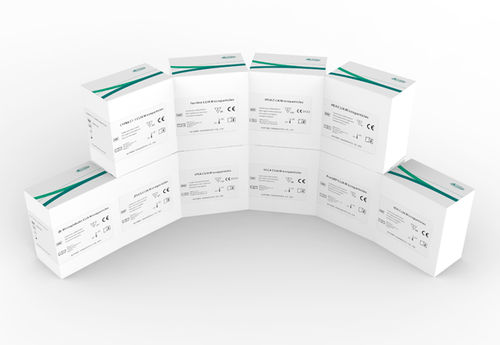
- Laboratory
- Laboratory medicine
- Lung cancer test kit
- Autobio Diagnostics
Lung cancer test kit CMB0202oncologyCEAclinical
Add to favorites
Compare this product
fo_shop_gate_exact_title
Characteristics
- Applications
- for lung cancer
- Application field
- oncology
- Tested parameter
- CEA
- Sample type
- clinical, serum, cell
- Sample volume
0.025 ml, 0.05 ml
(0.00085 US fl oz, 0.00169 US fl oz)
Description
Lung cancer is the second most commonly diagnosed cancer and the leading cause of cancer death in 2020[1]. Non-small cell lung cancer (NSCLC) accounts for the majority (approximately 85 percent) of lung cancers with the remainder as mostly small cell lung cancer (SCLC). For each patient with suspected lung cancer the overall goal is a timely diagnosis and accurate staging so appropriate therapy can be administered.
Blood-based biomarkers are valuable diagnostic tools for the management of lung cancer patients. They support not only differential diagnosis and histological subtyping, but are also applied for estimation of prognosis, stratification for specific therapies, monitoring of therapy response, surveillance monitoring and early detection of residual or progressive disease. [2]
CEA, CYFRA21-1 and NSE are tumor markers used for monitoring the response to chemotherapy in advanced adenocarcinoma, squamous cell carcinoma and small-cell lung cancer, respectively. ProGRP is a useful marker in SCLC, demonstrating association with survival in NSCLC and SCLC limited to univariate analysis.[3] SCCA has been confirmed to be closely related to the prognosis of lung cancer[4] ,especially squamous cell carcinoma.
Clinical Significance
Elevated expression of tumor CEA may be an adverse prognostic indicator in stages IB NSCLC. According to retrospective studies, high CEA level was a negative prognostic factor for survival and a risk factor for occult regional node metastasis in clinical stage I NSCLC patients undergoing surgery.
Catalogs
No catalogs are available for this product.
See all of Autobio Diagnostics‘s catalogsRelated Searches
- Autobio test kit
- Solution reagent kit
- Autobio blood test kit
- Autobio serum test kit
- Plasma assay kit
- Infectious disease detection kit
- Diagnostic reagent kit
- Respiratory infection test kit
- Autobio clinical test kit
- COVID-19 detection kit
- Bacteria reagent kit
- Antigen assay kit
- Clinical reagent kit
- IgG test kit
- Laboratory detection kit
- Autobio cancer test kit
- Autobio cell test kit
- Microbiology reagent kit
- Urine assay kit
- Lyophilized reagent kit
*Prices are pre-tax. They exclude delivery charges and customs duties and do not include additional charges for installation or activation options. Prices are indicative only and may vary by country, with changes to the cost of raw materials and exchange rates.









